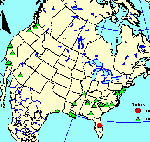Jim Gilbert

Tulip Home Page
Challenge Questions

Today's News

Spring's Journey North

Report Your Sightings

Teacher's Manual

Search Journey North

 A/CPB
A/CPBTulip Garden Update: February 13, 1998
Tulips Garden Updates Will be Posted on FRIDAYS:
Feb. 13, 27, Mar. 13, 27, Apr. 10, 24, May 8, 22
 The first tulips of Spring, 1998 are in bloom! Lockhart Middle
School in Orlando, Florida was the first to report this welcome sign of spring. According to gardeners in 17 other
states, the growing season of 1998 is now underway. Tulips have emerged in 30 gardens. The location of each of
these gardens is listed below, along with their latitude and longitude.
The first tulips of Spring, 1998 are in bloom! Lockhart Middle
School in Orlando, Florida was the first to report this welcome sign of spring. According to gardeners in 17 other
states, the growing season of 1998 is now underway. Tulips have emerged in 30 gardens. The location of each of
these gardens is listed below, along with their latitude and longitude.
- Click here to view data: Tulips Emerged
Official JN Garden in Houston, Texas
If you've made predictions for the 10 official Journey North garden sites, keep your eyes on Houston. On Tuesday
morning at 7:30 am the tip of the first tulip emerged. "It poured rain most of the day, and the temperatures
were warm. By the end of the day, it was twice as tall and a much darker green," reported Mrs. Leland.
The Green Wave of Spring
|
"Isopleth" |
Using this spring's tulip data, draw the wave (an isopleth) at regular time intervals to show spring's advance. The "given variable" could be "tulips emerged" and your "constant value" could be a certain date. For example, you might choose each Monday's date as the date you'll draw your line. All gardens in which tulips have emerged as of that Monday would be included. You would draw your line by connecting the dots where tulips have emerged. Each week you would draw another line until the wave of spring has advanced across the entire region.
Finally, at the end of the season, you could measure the distances between the waves and determine out how you would complete this sentence:
"Spring advances at the average rate of xx miles per day."
Spring's Journey NORTH?
As you look where tulips have begun to grow, you may be surprised. How would you answer this question?
Challenge Question #2
"Does spring truly move northward? Using today's data, describe the pattern you see. Explain what direction(s) spring is moving, and why you think this is so."
(To respond to this Challenge Question, please
follow the instructions at the end of this report.)
El Nino and Tulips
Our last Challenge Question asked whether you thought el Nino would affect the growth of tulips this spring. Plan to compare the 1997 & 1998 data regularly this season, and pay attention to temperature trends meteorologists describe. If you think warmer temperatures will cause faster growth, be sure to conduct the "Spring Fever" lesson for tulips so you can quantify this.
Here are some of the thoughts students had about this topic:
"The fourth graders and their teacher, Mrs. Wherley, at Winifred School think El Nino will affect the results
of Journey North's tulip study this year. After finding the monthly average temperature and precipitation for 96
and 97 we concluded the months of November and December of 97 were unusually dry and warm. We looked at the national
trend of weather changes due to El Nino. We believed this caused a warming of our weather also and this could contribute
to the early emergence of our Journey North tulips."
Winifred Elementary School
Winifred, MT
bdlee@concentric.net
The Montana fourth graders compared local weather statistics and also looked at:
Ms. Talbert's seventh grade science class searched on the WWW of different El Nino sites such as USA Today,
National Weather Service and The Santa Rosa Press Democrat newspaper. They decided, "Tulips might bloom earlier
because of warmer weather, more rain and more wind, especially on the west coast. Tulips might rot because of too
much moisture in some places. This might happen here in northern California. In southern California, flooding might
damage tulips. The rainstorms this year appear to be shorter, but harder here. It also appears to be warmer, with
less snow in the mountains here. So our tulips may bloom earlier than last year. We would like to check measured
data from past years to check out our theories."
Ms. Talbert's seventh grade science class
Laytonville Middle School
Laytonville CA
ltalbert@mail.mcn.org
How to Respond to Today's Challenge Question
How to Respond to Journey North Tulip Challenge Question # 2
1. Address an e-mail message to: jn-challenge-tulip@learner.org
2. In the Subject Line of your message write: Challenge Question # 2
3. In the body of the message, give your answer to this question:
Challenge Question #2
"Does spring truly move northward? Using today's data, describe the pattern you see. Explain what direction(s) spring is moving, and why you think this is so."
The Next Tulip Garden Update Will be Posted on February 27, 1998
Copyright 1998 Journey North. All Rights Reserved.
